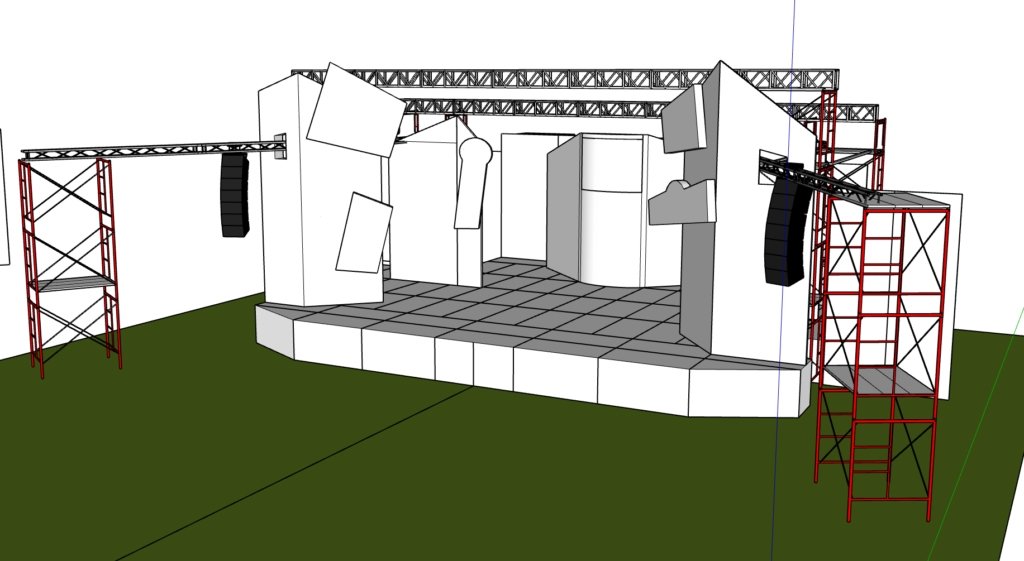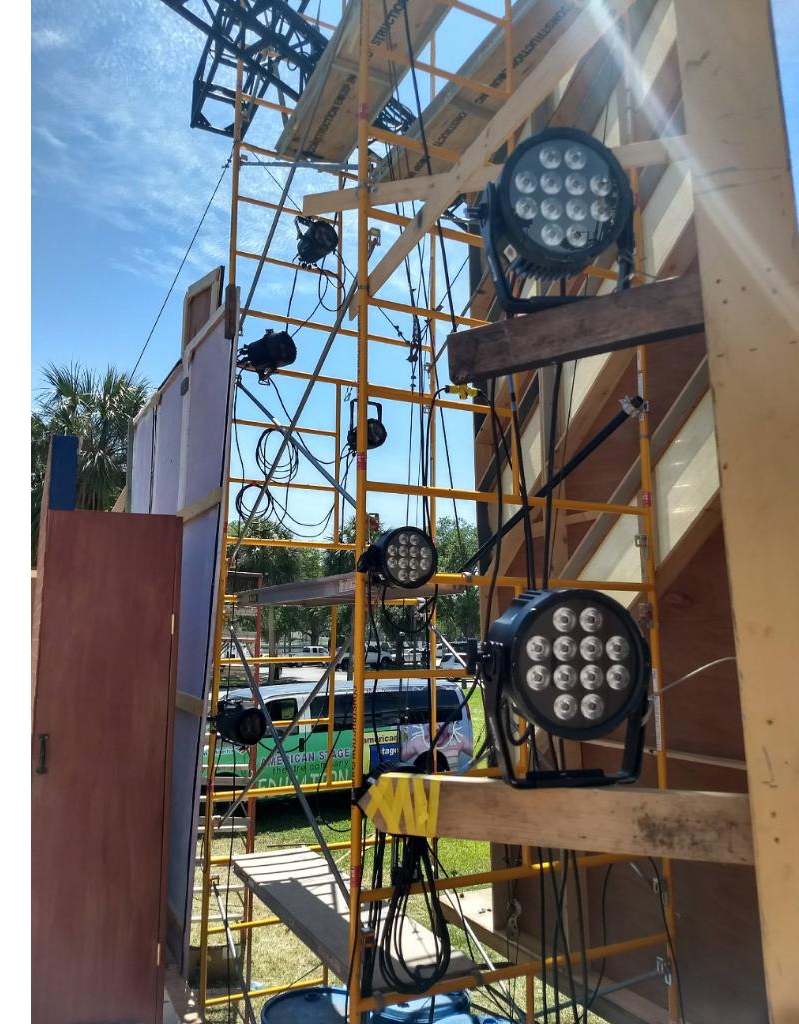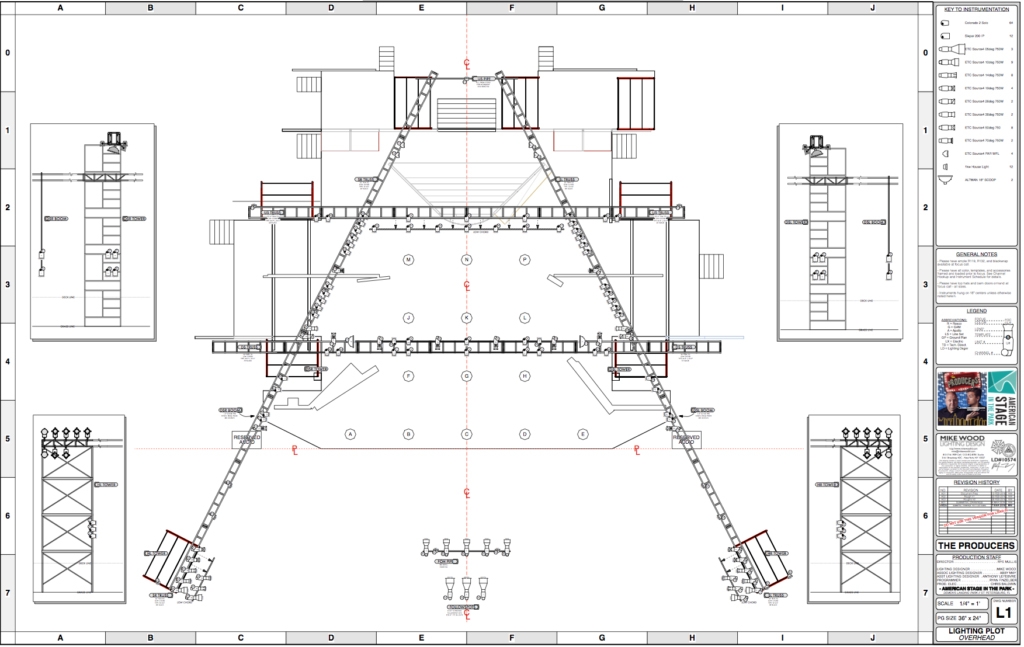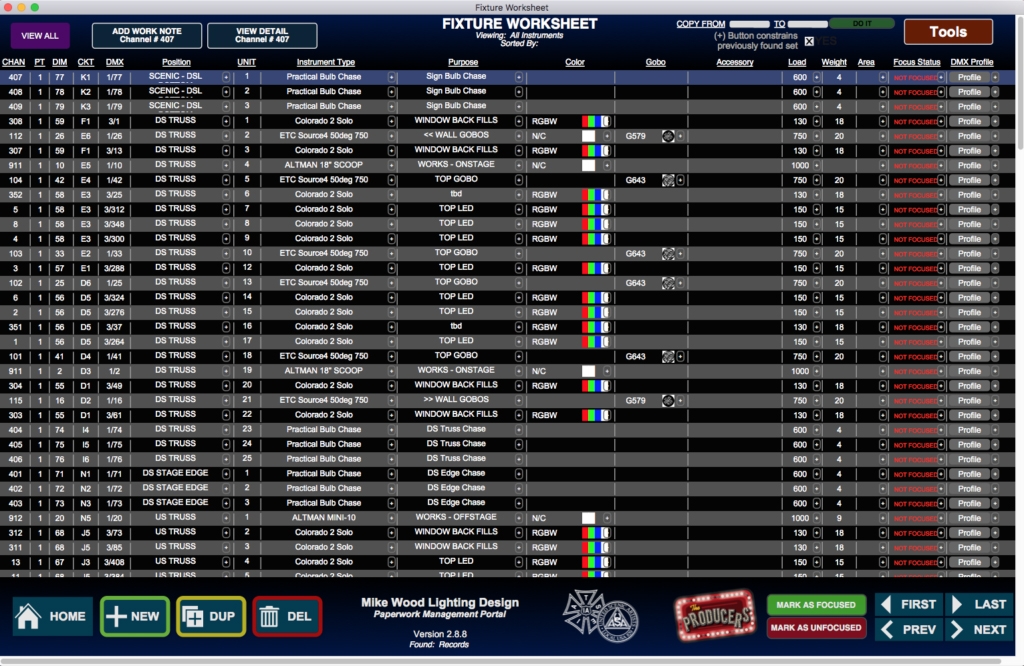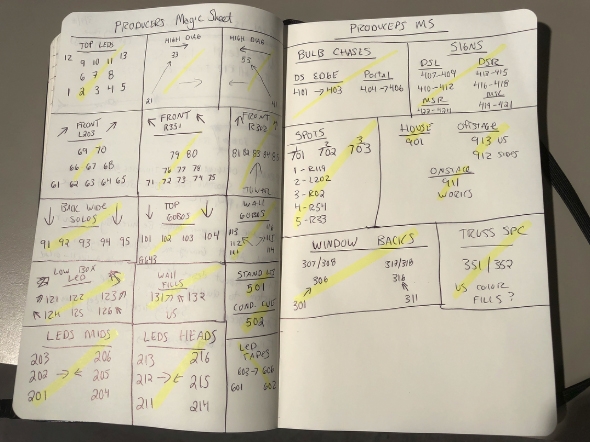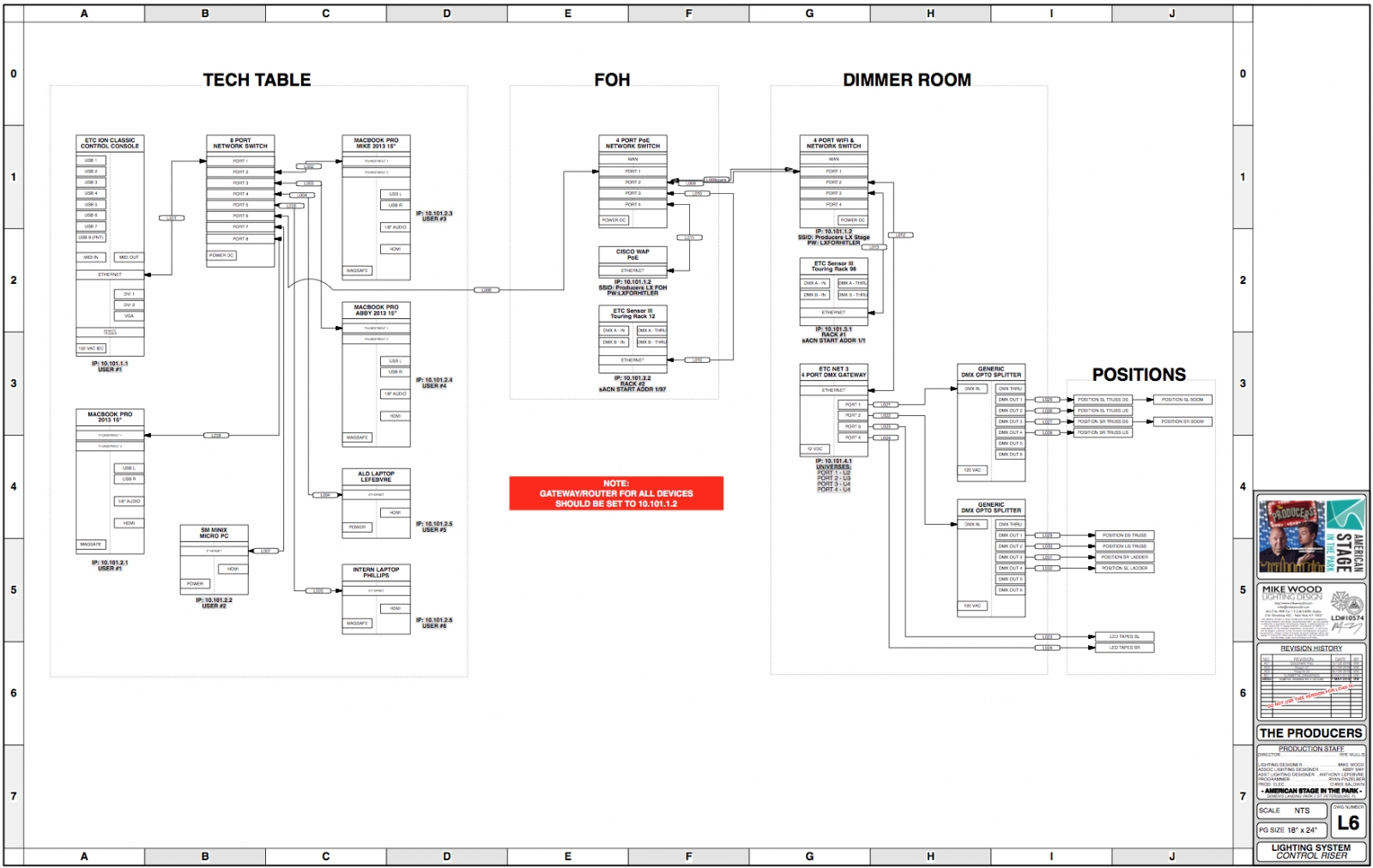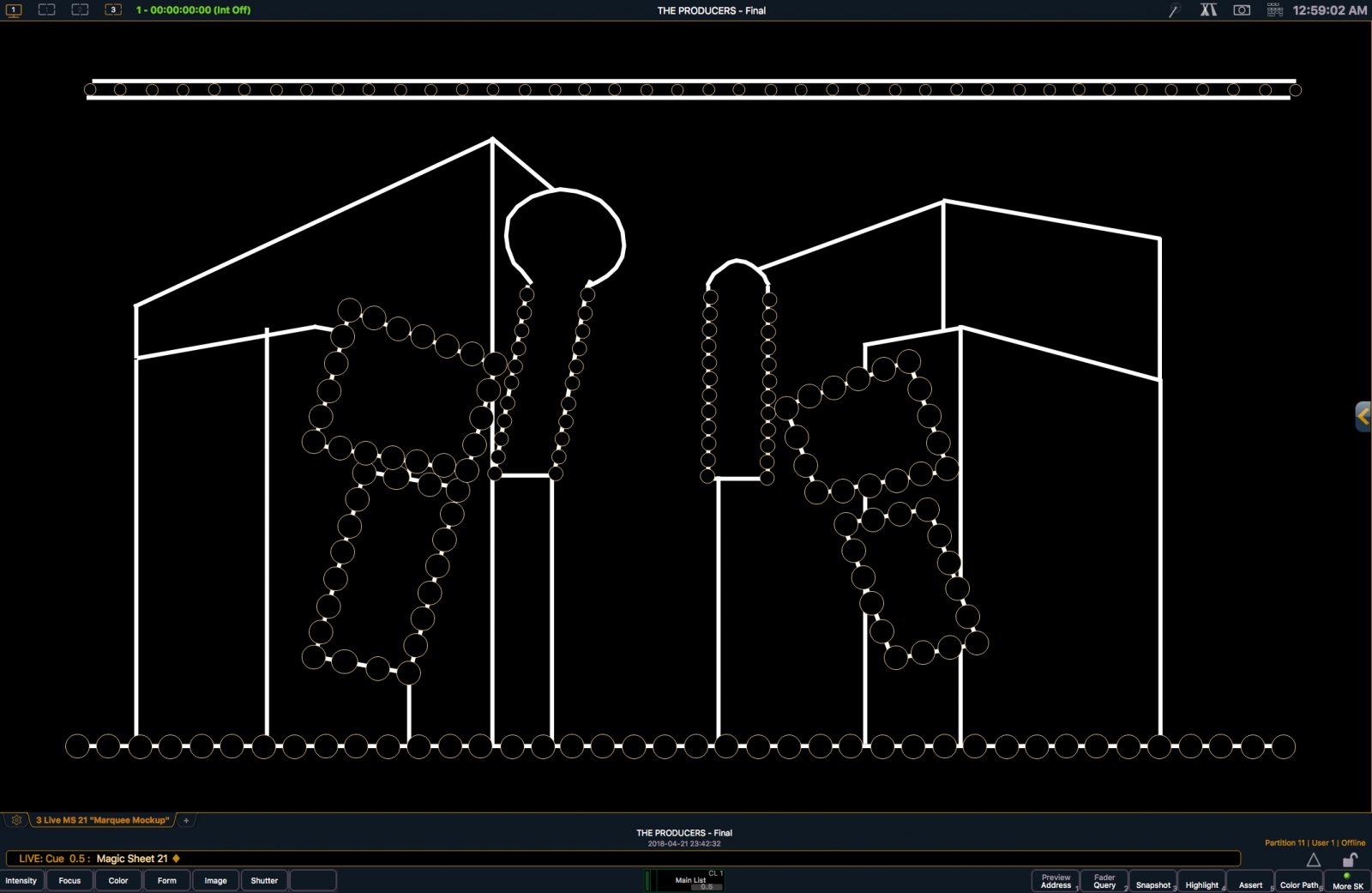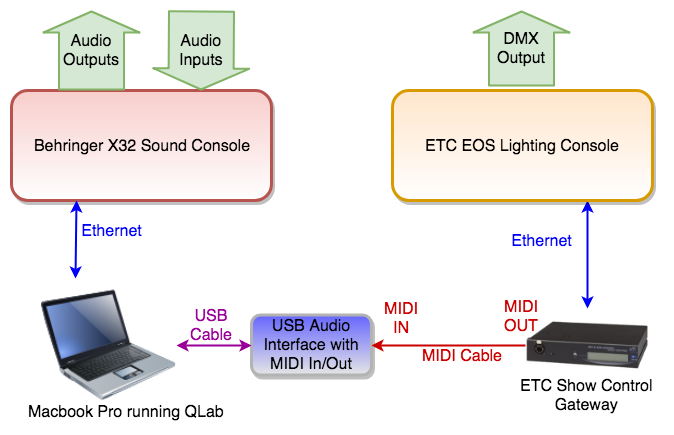Lighting Design In Depth: The Producers in the Park 2018
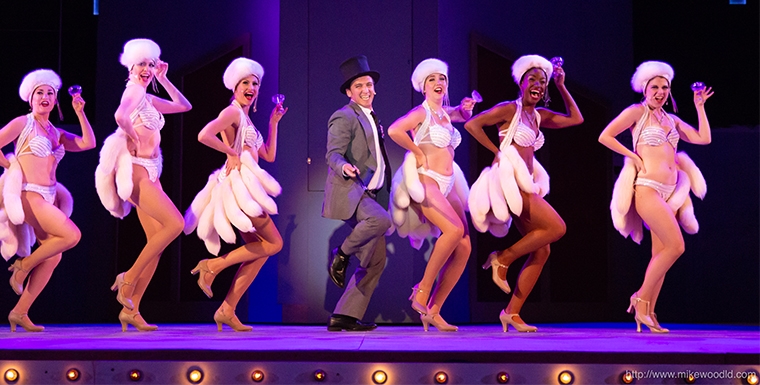
This week, we are joined in the Lounge by award-winning theatrical Lighting Designer Mike Wood. Mike put together this comprehensive article regarding the lighting design for The Producers performance at the American Stage in the Park. Mike fully documented the design process and shared light plots, cue lists, behind-the-scenes photos, and more!
I first wrote this for my personal blog at www.mikewoodld.com/blog/ - and I was honored when 4Wall asked me if they could share it in the Lighting Lounge. It's been a while since I wrote anything for the Lounge - my last post was almost 4 years ago (5 Things Student Designers Should Know). Hopefully, it won't be another 4 years in between posts this time!
I've always enjoyed sharing my work with other people - I do it mostly through photos on my Instagram page, though in the last few months I've decided that I want to spend some time writing about my work and focus on the design process. I recently finished working on an outdoor production of The Producers down in St. Petersburg, Florida and decided that this would be a good first test for this new venture. What follows is mostly an overview of the entire process that doesn't get overly specific about any one particular area, though my goal in 2018 is to write one post for each show that I do, focused on one particular part of the design process.
I hope you enjoy the article and hopefully get something from it. Please feel free to reach out if you have any questions or comments!
A very special thanks to my friend, Steve Kraack, who wrote the section on our show control systems.
Step 1: Assemble The Team
It's impossible to do such a complex production alone. For The Producers, I assembled a team of lighting professionals to join me in creating the show. Everyone has unique responsibilities and everyone is integral to bringing the production to life.
Abby May - Associate Lighting Designer
Anthony LeFebvre - Assistant Lighting Designer
Ryan Finzelber - Lighting Programmer
Ben Phillips - Lighting Intern
Abby and Anthony are both former students of mine from Howard W. Blake School of the Arts in Tampa, Florida.
Abby since went on to major in lighting design at UNCSA, graduating last year. She's currently the lighting supervisor for Ailey II in New York.
Anthony is currently a senior at the University of Central Florida in Orlando - this summer he will spend his time in Sag Harbor, NY at The Bay Street Theatre.
Ben Phillips is a current student at HWB School of the Arts in Tampa, where he is a technical theatre major with an emphasis in Lighting Design.
Ryan Finzelber is a Sarasota based freelance lighting and scenic designer and lighting programmer who has been working with me in a variety of roles since 2015.
Our production electrician for the show is Chris Baldwin, who is the house production electrician for American Stage. In addition to his work there, he has designed several shows in the area.
Step 2: The Design Process
The most complicated part of any park show is designing the complete system from the ground up. Literally the ground. We start with an empty field and end up with a full proscenium theatre, complete with lighting positions, dimming, circuitry, and fixtures.
The design process for The Producers started several months before any scaffolding was placed in the field and before any lights were ordered. Scenic designer and production manager Jerid Fox and director Rye Mullis met to discuss the needs of the show. From those meetings and conversations over the course of many weeks, Jerid began to create drawings and Sketchup models of the scenery.
The original drafts of the set are very similar to what we ended up with. Here's a look at the Sketchup model:
Once the scenic designs were finalized, it was the lighting team's turn to get to work.
The first design decision that I made was a complete accident. I was trying to adjust the side trusses that Jerid had in his Sketchup model and accidentally mirrored them upstage to be 80′ long instead of the typical 40′ that we've used in the past. I said to myself "Hey, that actually looks kinda cool…" The new trusses created a bit of a perspective when viewed from the front, helping to create the feeling of depth that Jerid was trying to accomplish with his wings and US scenic unit. He liked the accident as well, and so we kept it.
FINDING A VENDOR
From here, it was time to start playing with lights. Unlike the traditional regional theatre shows that I do, the park doesn't have any kind of a fixture inventory to work from. This is good and bad at the same time. Good, because I can basically pick whatever kinds of fixtures I want to use. Bad, because the fixtures that I choose have to be waterproof since they'll be outside in Florida for over a month - this severely limits the selection of gear. Then you've gotta find vendors who have the IP rated fixtures in stock for rental, which narrows the list down even more.
 I've been working extensively with 4Wall Entertainment in New Jersey for the last few years on a number of projects, including the system design and installation of two new theatres in an educational facility in Manhattan. When it came time to look for a vendor for this year's park show, I was pleased to find out that 4Wall was planning to open an office in Orlando, FL around the same time that this show would be happening.
I've been working extensively with 4Wall Entertainment in New Jersey for the last few years on a number of projects, including the system design and installation of two new theatres in an educational facility in Manhattan. When it came time to look for a vendor for this year's park show, I was pleased to find out that 4Wall was planning to open an office in Orlando, FL around the same time that this show would be happening.
Phil Foleen and I started talking about the possibility of doing the show together back in September of 2017. At the time, I figured it was a pipe dream - there'd be no way that that amount of gear (fixtures, truss, cable, dimmers, controls) would be in Orlando in time to get a local rental, and there'd be no way that we'd be able to afford shipping all of the gear in from another 4Wall location. Sure enough, the first quote came back at nearly 2x the entire lighting budget for the show.
Feeling a little discouraged, I reached out to Phil and said, "Alright, here's the bottom line. I have this much money to spend and honestly not a penny more - I will still probably be able to get some supplemental items, but I understand if this is not doable."
A day later I got a call from Phil, expecting to hear, "Yeah man, there's just no way." Much to my pleasant surprise, he opened the call with, "We're in!" And away we went. The Producers was to be the first theatrical show to happen for 4Wall in Florida, and they were willing to help however they could to make it happen.
 LET'S MAKE A LIGHT PLOT
LET'S MAKE A LIGHT PLOT
When I design an indoor theatrical show, my primary concern is what the lighting looks like on the actors. While this is obviously a priority in the park too, the limitations (and the scale) of the space make it so that I focus more on creating full-stage pictures rather than individual specific moments. The angles for front light kinda suck, so it's hard to get any real isolation unless it's a followspot.
For example - if I were doing The Producers in a standard proscenium space, I would probably have masking that hid all of my lighting instruments. In the park, there is no masking. We're going to see every lens, every fixture, every position. I design the plot with this in mind. The lenses become little dots of color that everyone can see.
Ultimately we decided on a mixture of two types of IP65 rated LEDs for the rig - the Chauvet Professional COLORado 2 Solos and the Elation SixPar 200s. The original plan was to use the SixPars for top/back light as well as side light, and then use the Solos for eye candy (They've got a zoom feature that looks sweet when you're seeing the lens (again, eye candy!) Due to some limitations in inventory, we ended up only using the SixPars as side light - and non IP ones at that. The Chauvets took care of everything else.
This change actually ended up being a blessing as it made it possible to run Powercon True1 all over except for the boom locations. Before that, we would have had to do all kinds of adapting and creative cabling.
The other big decision was on followspots - in previous years, we've had a pair of Lycian 1271 units on the FOH tower. While they've worked decently, we always had issues with ballasts going bad since they (the ballasts) had to be carried each night up the tower. They had to wrap the spots every night with tarps, it was a whole thing. Additionally, we wanted three followspots this year instead of the traditional two. (Seriously, half of the show is spent with Max/Leo +1 onstage.) We decided to go with 5° Source Fours with City Theatrical Yokes this year - a leap of faith that the brightness would work out, but cheaper overall and less maintenance required throughout the run. (EDIT: This choice turned out to be the wrong one. While the spots did work, they just weren't bright enough for me. Next year, it'll be back to regular spots!)
All of the conventional units are Source Fours lamped at 750w. No explanation really needed there. Plus, birds love landing on the 10° units.
CAPTURE MODEL
 The second step in the plot process is the Capture Model. While I don't typically make full models of my shows, I almost always do in the park because of the strange angles and moving scenery. It allows me to see what things will do in space before I get out there and minimizes surprises. In addition, it allows the programmer extra time to create the showfile before we get onsite. "Dark" time in the park is controlled by this little thing called the sun, so the more work that can be done in advance, the better.
The second step in the plot process is the Capture Model. While I don't typically make full models of my shows, I almost always do in the park because of the strange angles and moving scenery. It allows me to see what things will do in space before I get out there and minimizes surprises. In addition, it allows the programmer extra time to create the showfile before we get onsite. "Dark" time in the park is controlled by this little thing called the sun, so the more work that can be done in advance, the better.
I use Capture because it's relatively user-friendly, works well with ArtNet/EOS, and is actually really affordable compared to some other visualizers out there. I can also then create an executable file to use for design presentations.
​​​​
VECTORWORKS
Next up is taking the decisions I made in Capture and drafting an actual plot in Vectorworks Spotlight. This might seem a little backward to some, as Capture now supports Vectorworks importing - but since I'm using Capture as a way to actually make some design decisions, this workflow makes sense.
There's a lot of information that has to go on the plot. Part of the fun is figuring out how to best display all of the appropriate information in a way that both makes sense and is aesthetically pleasing. We ended up with several pages showing all of the details.
(CLICK PHOTOS TO ENLARGE)
LIGHTWRIGHT
There's a lot of it. Reports of every type sorted in different ways. I try to provide as much information as possible about the design and system so that there are no questions at load in.
This year, since all of the gear was coming in from New Jersey, we had to be very specific about cable so that we knew how much needed to be on the truck. I added some circuit and data line management features to the PMP, which allowed us to map out cable segments of all types and even generate a shop order list including additional spares.
Here are a few samples of some of the various reports that are created by the PMP. As you can see, literally every single circuit is detailed in advance with what cables and fixtures are on it.
LIGHTING PAPERWORK
There's a lot of it. Reports of every type, sorted in different ways. I try to provide as much information as possible about the design and system so that there are no questions at load in.
This year, since all of the gear was coming in from New Jersey, we had to be very specific about cable so that we knew how much needed to be on the truck. I added some circuit and data line management features to the PMP, which allowed us to map out cable segments of all types and even generate a shop order list including additional spares.
Here are a few samples of some of the various reports that are created by the PMP. As you can see, literally every single circuit is detailed in advance with what cables and fixtures are on it.
(CLICK PHOTOS TO ENLARGE)
MAGIC SHEET BEFORE/AFTER
THE CONTROL SYSTEM
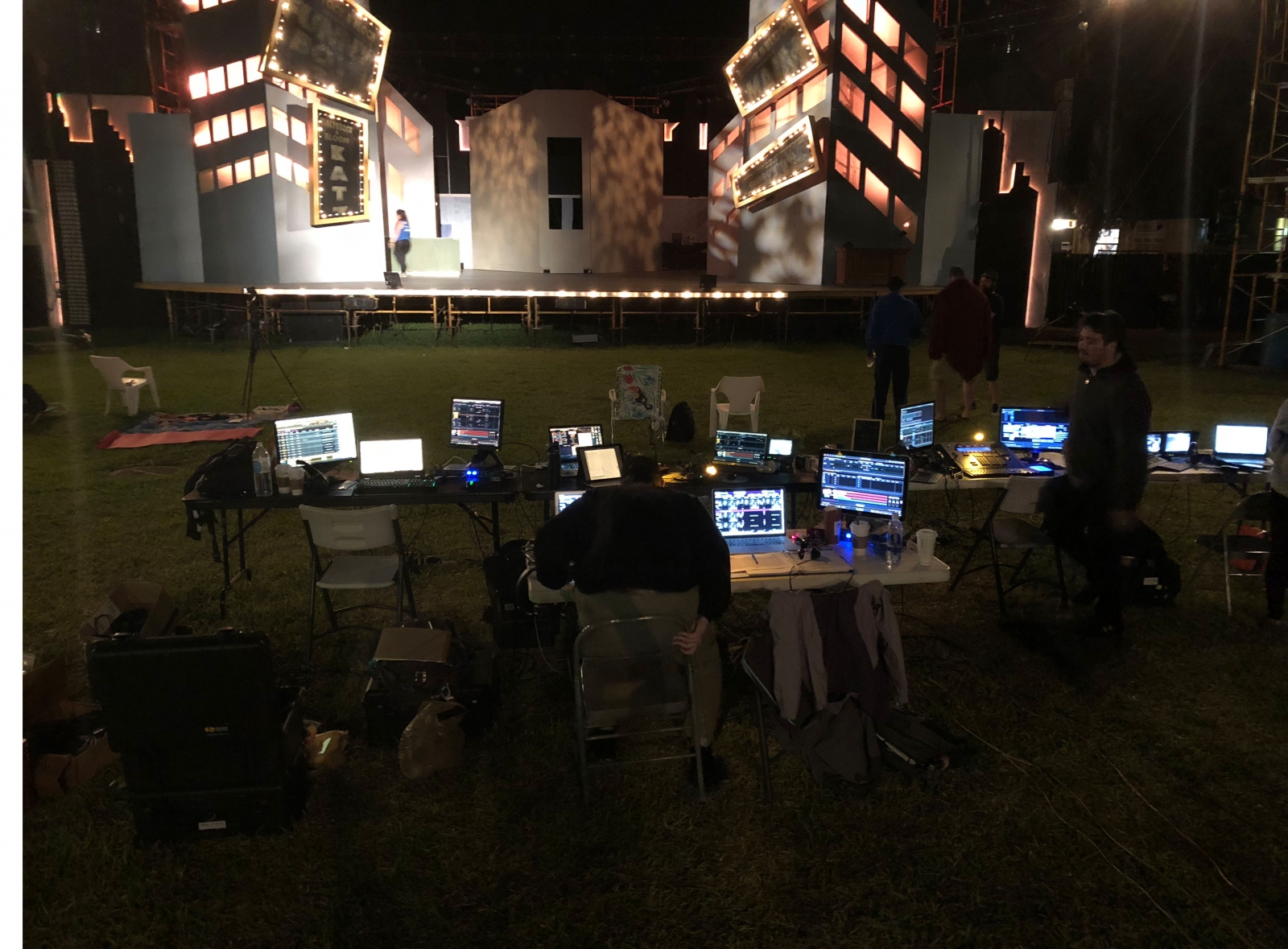 Haven't you ever set up a tech table and thought "gee, I wish I could set this up and strike it every single night!" If you did, please call me. Because I'd love to have you come do it.
Haven't you ever set up a tech table and thought "gee, I wish I could set this up and strike it every single night!" If you did, please call me. Because I'd love to have you come do it.
While the actual run of the show has a FOH booth, it's very far from the stage and doesn't really have room for more than the Stage Manager and the FOH audio mixer (Steve Kraack, who is fantastic.) We set up and strike our tech tables every night. By the final dress rehearsal, it goes pretty quickly.
(CLICK TO ENLARGE SYSTEM DIAGRAM)
The show is programmed on an ETC Ion console but is ran on a small Minix PC with an ETC Nomad Dongle because we don't like the idea of leaving the Ion outside for over a month.
In years past, we've had a handful of RVIs for everyone to see data. With the introduction and expansion of Nomad in the last few years, everyone now just uses their laptops which has saved money and setup time.
I have nomad running on my Mac, which allows me to see command lines and a PSD - the only two things I really care about on this project. Abby designed the followspots for the show, which are 5° Source Fours, so her Nomad is partitioned to be able to only work with those instruments and program on list 2. Anthony runs Nomad so that he can label cues and help Chris check on work notes. Even Ryan, the programmer, uses nomad on his computer set to the same user ID as the console. He puts the PSD on that screen so that the ion screen real estate isn't eaten up by it.
 All of these control units are networked together into the larger control network which consists of an ETC 4-Port DMX Gateway, an ETC Show Control Gateway, CEM III, and Sensor + Racks. There are wireless APs at FOH and backstage, which allow for iRFR access to the system as well as access to the locally hosted PMP database for the show. The whole system is network based until it gets to the DMX Gateway - this allows us to run one network cable to the tech table instead of several DMX lines.
All of these control units are networked together into the larger control network which consists of an ETC 4-Port DMX Gateway, an ETC Show Control Gateway, CEM III, and Sensor + Racks. There are wireless APs at FOH and backstage, which allow for iRFR access to the system as well as access to the locally hosted PMP database for the show. The whole system is network based until it gets to the DMX Gateway - this allows us to run one network cable to the tech table instead of several DMX lines.
The Show Control Gateway interfaces SMPTE and MIDI with the audio department. Unfortunately, we cut SMPTE during tech because there wasn't enough time to coordinate tracks with the orchestra, but we still make extensive use of MSC commands to integrate lighting and sound.
Step 3: Shop Prep
 Shop prep can make or break a show. There are nearly 80 LEDs in this show that need DMX addresses and modes set on them. Trying to do that when they're already in the air would take an entire day in itself. Instead, we spent two days prepping and labeling every piece of equipment for the show.
Shop prep can make or break a show. There are nearly 80 LEDs in this show that need DMX addresses and modes set on them. Trying to do that when they're already in the air would take an entire day in itself. Instead, we spent two days prepping and labeling every piece of equipment for the show.
Our friends at freeFall Theatre in St. Pete have a massive warehouse space a few miles from the park. They were kind enough to let us use the space for two days to do our work.
The Paperwork Management Portal creates all of the labels that we need for the show - everything from fixtures to dimmers to cable to truss. Each fixture yoke gets a label and a color code, and each connector gets a label detailing circuit and dimmer numbers.
We patch the dimmer rack, set the IP addresses on all of the networked equipment, test each light, and pack it by position back on the truck. It was a busy two days.
Step 4: Load In
 Load in takes place about a week or so from tech starting, which gives Chris plenty of time to get everything working. There was a crew of 6 working hard throughout the day to get everything in the air. Since we did extensive prep work, they were able to use the color codes to quickly sort and hang fixtures and truss as it came off the truck.
Load in takes place about a week or so from tech starting, which gives Chris plenty of time to get everything working. There was a crew of 6 working hard throughout the day to get everything in the air. Since we did extensive prep work, they were able to use the color codes to quickly sort and hang fixtures and truss as it came off the truck.
The crane arrives at 1:00 pm to lift the trusses into the air. Landing them properly requires a great deal of planning and precision. Since there are three levels to the trussing, they have to go up in a specific order and the locations need to be accurate within a few inches of the drawings in order for the lights to make their shots.
Step 5: Focus
Focus was led by Abby and Anthony on a very rainy Tuesday night. There were intense thunderstorms all day long and we were worried that we'd have to reschedule focus, which would have been a disaster as there was no extra time built into the schedule - again, we're at the mercy of the sun.
Luckily, the clouds parted just in time and focus was able to be accomplished on time.
Step 6: Programming
"AND WE'RE HOLDING FOR THE SUN"
We spend a lot of time in the park just waiting for the sun to go down so that we can work. This means that our work day doesn't really get started until 8:00 pm, sometimes 8:15 pm. While we can work late into the night, there's a city noise ordinance that begins at 11 pm which means that we can't have amplified sound past that time. That means that we get 3 hours of dark time to actually work with the actors onstage. 2:30 if you factor in breaks and such. 2:00 if we hold for other departments. The show run is nearly 3 hours long. You can see where I'm going here.
In addition to needing to wait for the sun to go down to program, we also have to keep it in mind when creating the show itself. As the run progresses, sunset gets progressively later. By the final week of the show, it might not be completely dark outside until halfway through act 1! Still, we cue the show as if it was going to always be completely dark from the top of the show. (Last year during Hairspray, the curtain was held for nearly an hour due to rain - but ultimately the show started and finished! That might have been the only audience to truly see the opening number with the actual cues instead of the sunset (which is a killer CYC, I'll admit.)
We ended up with about 400 called lighting cues in the show - over 100 of which are in "Springtime for Hitler" alone. (And 40 or so in "Betrayed") There are about 140 spot cues which are all programmed in a second list that is triggered from the main cue list. One of the handy features of my Paperwork Management Portal is the auto-insertion of executes into the main cue stack.
(CLICK EACH CUE LIST TO ENLARGE)
(CLICK TO SEE THE MAGIC THAT HELPED CREATE CHASES FOR THE SIGNS)
Step 7: Technical Rehearsals
The park show schedule typically looks like this:
Wednesday Night - Cueing (Actors work onstage on other things)
Thursday Night - Act 1 Q2Q
Friday Night - Act 2 Q2Q
Saturday Night - Full Tech Run
Sunday Night - Full Tech Run
Monday Night - Day Off
Tuesday Night - Dress Rehearsal
Wednesday Night - Preview #1
Thursday Night - Preview #2
Friday Night - Gala Opening
Saturday Night - Press Opening
This doesn't leave much time for rain delays or cancellations, which often happen. On Sunday, bad storms rolled in around 1 pm and didn't leave the area until almost 7. Everything was soaked with rain. The crew spent the first hour and a half of rehearsal drying everything off enough to make it safe to rehearse. (Since most of the rig was LED, we could be little help in the drying process…) We also didn't want to do a full tech table setup in case the rain came back.
During the technical rehearsals, cues are changed, deleted, added, refined, cursed at, and more. The associate LD, Abby May, spends most of the time working with followspot cues and operators, ensuring that they learn the show by the time it opens. More paperwork is generated (see image right) for the followspots.
Worknotes get added every night. In a typical show, the crew would come in before the next day's rehearsal to get work and focus notes done before the rehearsal starts. In the park, we have to get them done the same night because, once again, of the sun.
SHOW CONTROL / SYSTEM INTEGRATION
Here's a guest spot from Steve Kraack, our brilliant sound designer and engineer for the show:
Creating a professional-looking and sounding production is the end goal for all producers, directors and designers. And doing this on a limited budget is an ever-growing requirement. Reducing staff through technology is one goal, but the more important goal for me, as a designer, is the incredible precision and consistency a production can maintain using integration and automation of multiple production systems. As the Sound Designer and Engineer for American Stage's 2018 production of THE PRODUCERS in the park, I needed to increase my capabilities by using automation to simplify my workflow and allow my simple, one-track mind to focus on the mix each and every night. This frees me from the script, the sound effect playback, and from navigating the many deep layers of the sound board to make theatre magic happen.
 Allow me to list a few stats before I explain how it works. 52 Audio inputs, 20 Wireless Mics, 16 Audio Outputs, 11 different mixes, 6-piece live orchestra, 3 effect channels, 35 Sound Effects, 575 Individual Sound Board actions grouped into 97 grouped and scripted cues. All completed in a 2 hour and 45 minute show, 5 nights a week for 4 weeks. The ability to complete and manage all of those tasks with quality and consistency requires automation.
Allow me to list a few stats before I explain how it works. 52 Audio inputs, 20 Wireless Mics, 16 Audio Outputs, 11 different mixes, 6-piece live orchestra, 3 effect channels, 35 Sound Effects, 575 Individual Sound Board actions grouped into 97 grouped and scripted cues. All completed in a 2 hour and 45 minute show, 5 nights a week for 4 weeks. The ability to complete and manage all of those tasks with quality and consistency requires automation.
In this diagram, we can see a simple layout of how systems are connected. But how does information flow to make this work? Well, we start with the execution of a GO command from the EOS Lighting Console. With GO, an MSC (MIDI Show Control) command is sent via ethernet to the Show Control Gateway. The Gateway is setup to broadcast that signal via the MIDI Out port. I use Figure53's QLab to automate my sound board commands. I use QLab for many reasons, but mostly because it allows me to send OSC or MIDI commands to almost any digital sound board out there today. QLab also allows me to listen for MIDI commands and perform actions when I receive that signal. QLab will listen for the MSC command on the MIDI IN port of an Audio Interface connected via USB to my MacBook Pro running QLab. All that is required is for the QLab cue numbers to match the MSC cue number sent from the EOS Console… and like magic, it will trigger QLab cues as well. It is almost too simple not to do it all of the time.
This setup does require some planning from technically capable designers, but in the end, it is doable by anyone on a minimal budget. I have used similar setups for small community theatre, educational youth theatre, high school performances, and professional theatre. My experience shows that it has always worked very well and is clearly ready for professional quality work in any production environment. In previous shows, If my sound console was in close proximity to the EOS Lighting Console, I can plug directly into the MIDI OUT on the Console. In that case, the Show Control Gateway is not required.
The final component to make theatre magic happen is a lot of programming in QLab and on the Sound Console. When light cues are triggering sound cues, it requires clear communication of when cues happen and what is expected to happen, for both lights and sound. Timing is everything. My best example is a Blackout Cue at the end of Act 1 before Intermission. When the Stage Manager calls the Blackout cue, the GO button is pressed on the EOS Light Console, an MSC command is sent, QLab responds at the exact same time with a series of commands to the sound board. Big Finish before Intermission, right! I want that final sound to resonate and linger after the blackout, with no distractions. Lights go black. QLab instructs the sound board to bring all 20 wireless mics out, the orchestra mics on a different sound board layer to go out, hold for 7 seconds for the ring and applause, then automatically trigger another cue to fade up intermission house music synced to fade up with the house lights. This all happens with no interaction by the engineer. As the designer, I can control the timing of each action and make sure cues happen in the same manner each and every night. It also simplifies the role of the sound engineer by reducing the workload to a manageable level allowing them to focus only on the mix. Cueing is controlled from a master source and triggered by the Stage Manager. Theatre magic!
Contribution by Stephen Kraack, Sound Designer
Technical Director at Theatre Arts & Dance Alliance, Lithia, Florida
Contact at Steve@kraack.us
Step 8: Dress Rehearsals
Dress rehearsals are the time when everything happens just as it will in a real performance. Or so we hope. We only really got one dress rehearsal for the show since the rain kept us from working on Sunday night, and we spent most of that dress rehearsal furiously scribbling down notes and fixing them as quickly as we could.
Step 9: Previews
I spent the majority of the two preview performances moving around in front of the stage taking photos of the show. We didn't have wireless comm out there, so I was on the phone with Anthony back at the tech table trying to yell whatever notes I saw over top of the speakers 10′ from my face.
The previews give the cast a chance to work with the audience for the first time. We learn what is funny, where we need to add pauses, where something isn't quite working. The goal is to never stop the show, but as we tell the audience when they sit down, it's still a rehearsal.
The first preview went off without a show-stopping incident. There were a few prop mishaps - the stack of scripts for Max and Leo was nowhere to be found… when Max opens the safe to show Leo an empty void where they will one day put their money… there was already a million dollars in it. Fun stuff like that.
The second preview was going along just swimmingly when all of the sudden, the major scenic unit spins around during Springtime for Hitler and the door doesn't open. A temporary latch had been installed that day and it had gotten stuck. Our PSM, Rachel, got on the god mic and called a hold and the problem was reset. I think it's kinda fun to be in a preview audience when something goes wrong like that.
Step 10: Opening Night
American Stage opens their park show every year with its annual Gala Under the Stars event, where the theatre raises money for their production and educational programs. The field is filled with tables, there's a live and a silent auction, and everyone has an amazing time.
 Pictured from Left to Right:
Pictured from Left to Right:
(Front Row) Chris Baldwin, Ryan E. Finzelber
(Back Row) Phil Foleen (4Wall), Ben Phillips, Mike Wood, Abby May, Anthony LeFebvre

